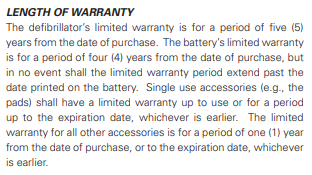We bought a Defrib Unit for our workplace 2 years ago, since it’s one of those things we thought would be good to have in addition to a medical kit. It’s very simple and easy to use.
The unit started to beep constantly back in February and on investigation, it seems the battery was flat, cannot be recharged, and needs to be replaced. The manual for the unit said it should last 4 years and was warrantied for 4 years. It was within the warranty expiry date printed on the battery.
Emailed the local Victorian supplier (Unit is from USA) and they said, no, the battery is a consumable and not warrantied. We pointed out what the manual said and they reluctantly agreed to take it up with the importer, in Sydney.
Long story short, the importer agreed to claim a bettery under warranty from the manufacturer.
It’s the beginning of June and now we’ve been told the new battery should be here at the end of the month.
It feels like a scam and the whole warranty and consumable thing just stinks to be honest. In the USA they honour a 4 year warranty and out here it is regarded as a consumable … nice business if yo can get it.
Is this something to take up with Consumer Affairs?
It’s of no use at all without a battery and we bought it so it is available in case we need it,but if we have to wait months every time a battery is needed … well, have to rethink this one?
